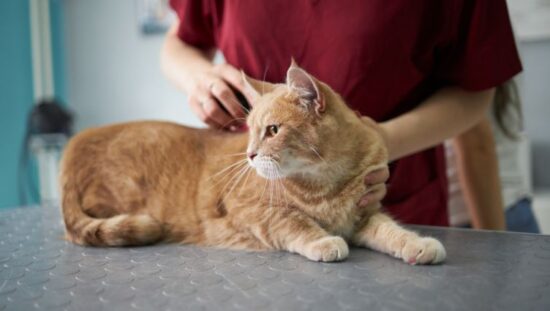Welcome to our guide on dealing with cat allergies! If you’ve noticed your cat sneezing a lot, scratching like crazy, or having irritated skin, you’re in the right place.
We’re here to help you figure out what’s going on and how you can make your cat feel better.
In this article, we’ll cover everything you need to know about cat allergies. We’ll talk about the signs to look out for, how vets figure out what’s causing the trouble, and the best ways to help your cat feel more comfortable. Let’s learn how to keep your furry friend happy and healthy by giving them the care they need!

What Exactly Are Allergies?
Cats can get allergies when their body reacts strongly to substances around them, like pollen, dust, food, or flea bites. Their immune system thinks these things are dangerous and releases chemicals that cause allergy symptoms. Allergies are relatively common in cats and they can show up in cats of any age.
It’s important to recognize and treat allergies in cats because they can cause itching, scratching, sneezing, and other problems. Allergies can lead to infections and make your cat feel miserable if they are left untreated. By spotting the signs early and working with your vet, you can prevent more serious issues in the future.
Types of Allergies in Cats
As we mentioned previously, things like certain foods, flea saliva, pollen, mold, dust mites, or even certain medications can cause allergies. Your cat’s allergy type should be determined for effective management and to ensure his comfort and well-being. In the text below, we’ll explore the common types of allergies in cats and discuss how to recognize and manage each one effectively.
1. Food Allergies
Food allergies happen when a cat’s body reacts to specific ingredients in their food, much like how they affect people. Common allergens are proteins found in beef, chicken, fish, or grains. Cats with food allergies usually scratch a lot, have tummy troubles, or get ear infections. Vets can figure out if food is the problem by trying different foods or doing allergy tests. Switching to a special diet can often help.
2. Flea Allergies
Flea allergies are common in cats and happen when they’re allergic to proteins in flea spit. Just one flea bite can make a sensitive cat itchy. They might scratch a lot, especially around their tail and back legs, and lose hair. It’s important to stop fleas by using flea treatments regularly and getting rid of them from your cat and your home.
3. Environmental Allergies
Environmental allergies happen when a cat’s body reacts to things like pollen, mold, dust mites, or certain cleaning products. These allergens can cause sneezing, watery eyes, itchy skin, or breathing problems. To help your cat feel better, try to keep them away from things they’re allergic to. Your vet might suggest medicines like antihistamines or shots for severe cases.
Common Symptoms of Allergies in Cats
In this section, we’ll explore the common symptoms and signs that may indicate your cat is having allergies. From itching and sneezing to more serious signs like difficulty breathing or gastrointestinal issues, understanding these symptoms can help you identify when your cat needs veterinary attention. Let’s dive into the list of common allergy symptoms in cats.
- Itching- Cats with allergies often scratch or lick themselves a lot, especially on their face, ears, belly, or paws.
- Skin Irritation- Allergic reactions can lead to redness, swelling, or small bumps on the skin, known as hives or dermatitis.
- Sneezing- If your cat sneezes often, it could be a sign of allergies, especially if they also have a runny nose.
- Watery Eyes- Allergies may cause your cat’s eyes to water or become red and irritated.
- Coughing- Cats with respiratory allergies may develop a cough, which can be dry or produce phlegm.
- Gastrointestinal issues- These issues can lead to vomiting or diarrhea.
- Ear Infections- Allergies can contribute to ear infections, causing redness, discharge, bad smell, or constant head shaking.
- Chronic Ear Scratching- If your cat keeps scratching at their ears a lot, it could mean they’re having an allergic reaction or ear mites.
- Difficulty Breathing- In severe cases, allergies can cause respiratory problems, including wheezing, labored breathing, or open-mouth breathing.
Diagnosing Cat Allergies
If you think that your cat may have allergies, it’s important to consult with your veterinarian for a proper diagnosis. Your vet will consider your cat’s medical history, symptoms, and diagnostic test results to determine the underlying cause of their allergies. Also, they can suggest the best ways to help your cat feel better, so they’re not uncomfortable and can enjoy life more.
To diagnose food allergies, your veterinarian may recommend an elimination diet. This means giving your cat a novel protein or hydrolyzed diet for a set period, while not giving them any other foods. If your cat’s symptoms improve during this trial period and get worse when they eat certain things again, it could mean they have a food allergy.
For environmental allergies, such as pollen, mold, or dust mites, your veterinarian may perform skin or serum tests. Skin tests include putting small amounts of allergens under your cat’s skin and watching for reactions. Blood tests can also find certain antibodies to common allergens in your cat’s blood.
To diagnose flea allergies, your vet will look at your cat and check their symptoms. They’ll see if there are signs of fleas, like flea dirt or bites. They might also suggest ways to control fleas to be sure of the diagnosis.
Treatment Options for Cat Allergies
If your cat is dealing with allergies, finding the right treatment can make a big difference in their comfort and happiness. Fortunately, there are a couple of options available to help manage their symptoms, so let’s go through them:
1. Avoidance
Avoiding the things that make your cat allergic is often the best way to help them feel better. If you can figure out what’s causing the allergy, like certain foods or plants, keeping your cat away from those things can help.
For example, if your cat is allergic to pollen, keeping them indoors during high pollen seasons or using air purifiers in your home can reduce their exposure. If your cat has a food allergy, switching to a diet that doesn’t contain the allergen can make a big difference.
2. Medications
Sometimes, your vet might give your cat medicine to help with their allergies. These medicines can include things like antihistamines, which can reduce itching and sneezing, or corticosteroids, which can help with inflammation. It’s important to follow your vet’s instructions carefully and watch out for any side effects.
Antihistamines can be given orally or as a topical treatment, while corticosteroids are typically given orally or through injections. Your vet will determine the appropriate medication and dosage based on your cat’s specific needs.
3. Immunotherapy
For cats with allergies to things like pollen or dust, your vet might suggest immunotherapy. This means giving your cat small amounts of the allergen over time to help their body get used to it. It’s a long-term treatment, but it can really help reduce your cat’s allergic reactions.
Immunotherapy is often given through injections or liquid drops under your cat’s tongue. Your cat will need to visit the vet regularly for these shots or drops, but a lot of cats start feeling much better after a while.
4. Flea Control
If your cat is allergic to flea bites, keeping fleas away is super important. Your vet can recommend treatments to get rid of fleas on your cat and in your home. Keeping your cat and their environment flea-free can help prevent allergic reactions.
Flea control measures can include topical or oral flea preventatives, flea collars, and environmental treatments such as sprays or foggers to eliminate fleas from your home. Brushing your cat regularly and vacuuming your home often can also lower the number of fleas and make your cat’s allergic reactions less severe.
5. Managing Food Allergies
As we mentioned before, your vet might suggest trying an elimination diet. Feed them a new protein or hydrolyzed diet for 8-12 weeks. Keep an eye out for improvements, then reintroduce one ingredient at a time. Switch to the new diet slowly, avoiding foods that often cause allergies, like beef, dairy, fish, chicken, or grains. Stay patient and work closely with your vet to find the right diet for your cat.
Home Care and Management
You can help your cat feel better by making changes in their environment to reduce allergens they come into contact with. Here are some tips for creating a comfortable and allergen-friendly environment for your cat:
- Use Air Purifiers- If possible, use a high-quality air purifier with a HEPA filter to help remove pollen, dust mites, and pet dander from your home’s air. Put the air purifier in rooms where your cat spends the most time, such as the living room or bedroom.
- Frequent Cleaning- Vacuum carpets, rugs, and upholstered furniture often, use a vacuum cleaner with a HEPA filter to trap allergens effectively. Wash your cat’s bedding and your own regularly in hot water to remove allergens. Also, regularly dust surfaces and mop floors.
- Choose Hypoallergenic Bedding- Choose hypoallergenic bedding for your cat’s sleeping spot that’s less likely to cause allergies, like washable pet beds made of synthetic materials or allergen-proof covers for existing beds. These materials can make your cat’s sleeping area cleaner and more comfortable.
- Regular Bathing and Grooming- Bathe your cat regularly using a gentle, hypoallergenic shampoo recommended by your vet. Bathing your cat helps get rid of allergens from their fur and skin, which can make allergic reactions less likely. Also, brush your cat’s fur often with a special pet brush or grooming mitt to get rid of loose hair and dander.
When to See a Veterinarian
It’s really important to see a vet as soon as you notice your cat having allergic reactions. Getting help early can make your cat feel better and stop any big problems from happening. If your cat is scratching a lot, has red skin, sneezes, throws up, has diarrhea, or acts strangely, it’s time to take them to the vet.
When visiting the vet, give detailed information about your cat’s symptoms, medical history, diet, and environment. Together with the vet, you can make a plan to help your cat feel better. Regular follow-up visits are important to make sure your cat is getting better and to change the plan if needed.
Explore our expert care tips to ensure your cat’s health and well-being—read our guide “How to Keep Your Cat Healthy” for a happier, healthier pet!
Conclusion
Taking care of a cat with allergies isn’t always easy, but it’s worth it to see them happy and comfortable. By paying attention to signs of allergies, getting help from the vet when needed, and doing what you can at home, you’re making a big difference.
Remember, your vet is there to help you figure things out and find the best ways to manage your cat’s allergies. Watch how your cat is feeling, and if you’re worried about anything, don’t hesitate to ask for help.
With love, patience, and teamwork, you can give your cat the best possible care and help them live their best life, even with allergies.


